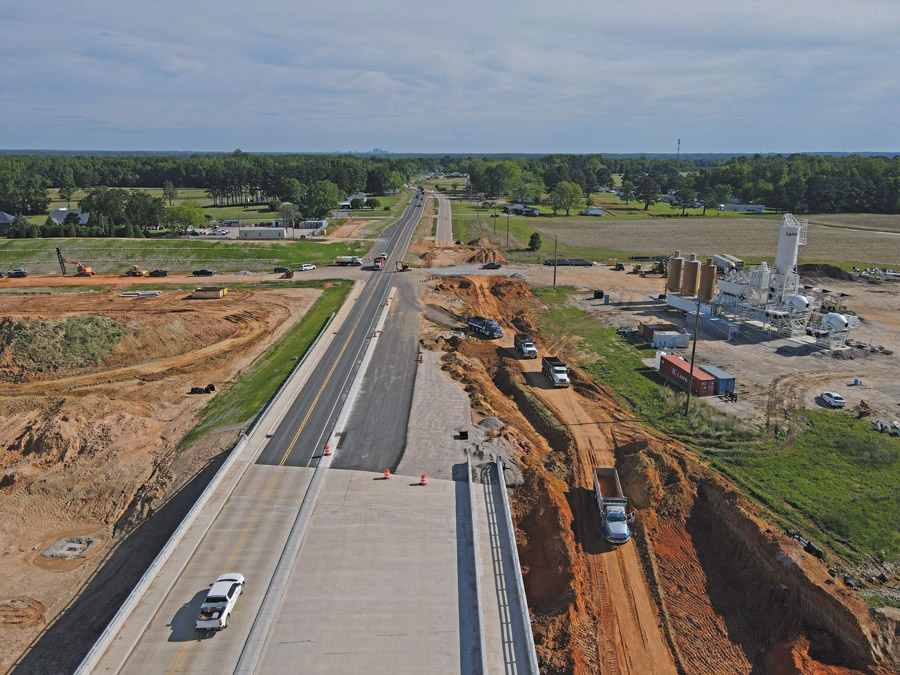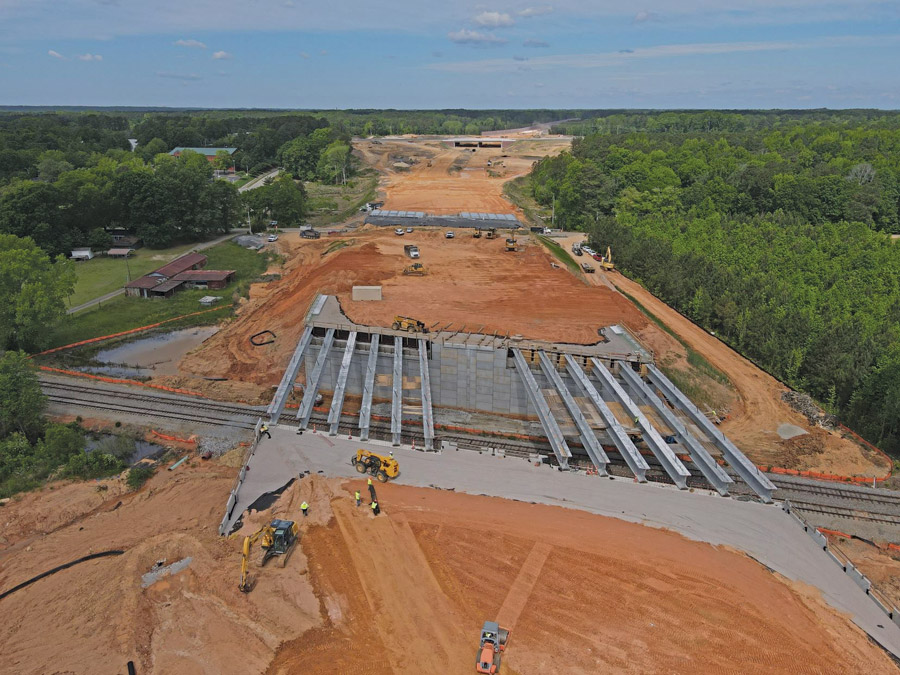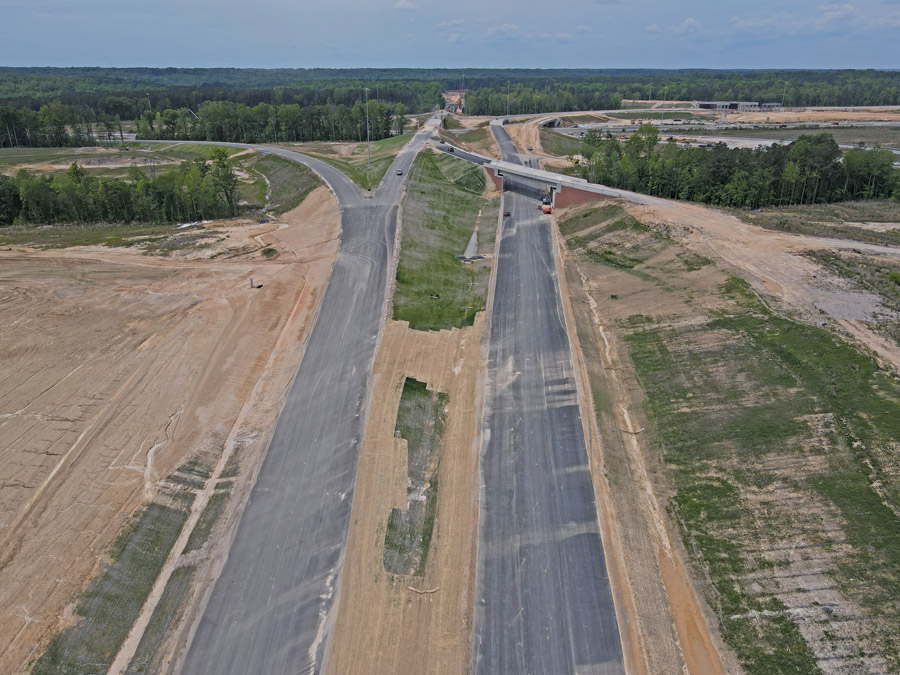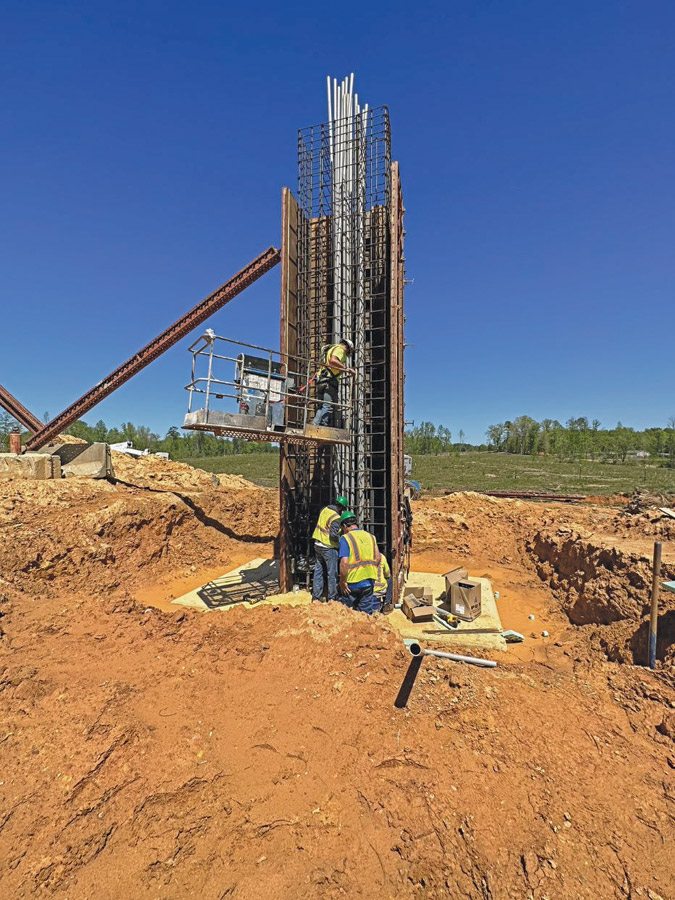The construction of a $2.3-billion toll road around North Carolina’s capital city has meant blasting through rock and hills, moving communications towers and relocating residents as the construction project focuses on a 2024 opening that will connect eastern and southern Triangle region communities.
The Complete 540 project, set to complete the outer loop around greater Raleigh, is the largest investment in highway infrastructure in NCDOT history, says Logen Hodges, director of marketing and communications for the North Carolina Turnpike Authority (NCTA) and North Carolina Dept. of Transportation (NCDOT).
It’s an area that desperately needs the capacity. People relocating to North Carolina from other states accounted for about 100,000 new residents from 2022 to 2023, according to NC.gov.
The Triangle region specifically—Raleigh, Durham and Chapel Hill—is growing due to the presence of science/technology-related companies like Cisco, IBM and SAS. The Economic Development Partnership of North Carolina notes that those companies’ workers have moved to the area, driving economic growth near Research Triangle Park.

A project-specific concrete plant provides a steady supply of material for the project’s eastern portion.
Photo courtesy Summit Design & Engineering
With Complete 540, NCDOT plans to significantly reduce traffic on the region’s major throughways, including I-440, I-40, NC 42, NC 55 and Ten-Ten Road. NCDOT began planning studies in 2009. NCDOT and NCTA plan to issue and award two design-build contracts in the second half of 2023.
“Once the project is completed, the new expressway will provide a more reliable travel time and an alternative route for motorists in and around the Raleigh area and surrounding communities,” says Dennis Jernigan, acting chief engineer with NCTA.
The project includes wide shoulders and lighting along the entire project corridor as well as electronic tolling and wrong-way vehicle detection technology, Hodges says, and is funded through a combination of toll revenue-supported debt and NCDOT funds. Toll revenue-supported debt includes both Transportation Infrastructure Finance and Innovation Act (TIFIA) loans and toll revenue bonds.
In March, NCTA issued the final request for proposals to design-build teams that were short-listed to provide bids on one section of Complete 540 Phase 2. The final RFP for the other section of Phase 2 was issued in May.
“The design for the Complete 540 project strikes a balance between minimizing impacts to the human and natural environments while meeting or exceeding design and safety standards,” Jernigan says.

Four bridges over a railroad crossing await deck construction on the Complete 540 project.
Photo courtesy Summit Design & Engineering
Breaking it Down
The project, also known as the Southeast Extension, is being constructed in two phases. Phase 1 will extend Toll N.C. 540 from the existing terminus at NC-55 to I-40 and Phase 2 from I-40 to I-87 in Knightdale, completing the outer loop around the greater Raleigh area, Hodges says.
Phase 1, which is further divided into three sections, begins with the extension of the Triangle Expressway 18 miles from N.C. 55 to I-40/U.S. 70, he says, at a construction cost of $183.5 million. The second section is $160 million, and the third is $403.2 million. Adding that almost $750 million construction cost to right-of-way, utility, environmental mitigation and other related costs brings the total Phase 1 cost to $1.3 billion. Phase 2 will be delivered by two design-build contracts totaling more than $600 million. When added to other project costs similar to Phase 1, it will total just more than $1 billion.
Flatiron and Branch Civil are managing two sections of Phase 1 as a joint venture, and a Lane and Blythe Construction joint venture is managing the final section.
The Flatiron-Branch joint-venture team is the design-build contractor for two of the Toll NC-540 projects, totaling $343.5 million, according to Caleb Linn, Flatiron vice president and district manager for North Carolina.
Cumulatively, these projects feature 23 bridges, he says, for which Flatiron’s structures team is responsible, and nine miles of new six-lane divided toll roads that extend the NCTA’s toll facility through southeast Wake County.
“The design ... strikes a balance between minimizing impacts to the human and natural environments while meeting or exceeding design and safety standards.”
—Dennis Jernigan, Acting Chief Engineer, North Carolina Turnpike Authority
Phase 1 construction, which began in December 2019, is approximately 77% complete and is anticipated to open to traffic in the spring of 2024. He says Phase 2 will extend the Triangle Expressway 10.2 miles from I-40 to the existing I-540 at I-87/U.S. 64/U.S. 264 in Knightdale.
The Triangle Expressway, a six-lane 18.8-mile toll road, connects NC 540 between NC 55 and NC 54 in Wake and Durham counties. It was completed in 2012 at a cost of $1 billion to improve travel and commute times in and out of the Research Triangle Park.
And constructing a new road around a fast-growing metro area requires a few twists and turns as well as walking a fine line through established neighborhoods.
There are approximately 10.5 million cu yd of earthwork in Phase 1, and the terrain is considered rolling, but the cuts and fills are generally only up to the range of 25 to 30 ft, Jernigan says.
“Very minimal blasting was needed for the project, and it was mostly for drainage, getting to subgrade in cuts and achieving ditch grades,” Jernigan says.

The two-level turbine-style interchange replaced a three-level design, saving $15 million.
Photo courtesy Summit Design & Engineering
Birds, Cell Towers and Neighborhoods
Phase 1 is adjacent to many residential areas along the project, so to ensure that neighbors are aware of any upcoming construction activities, Hodges says it is engaged in a “robust public outreach effort.”
The effort includes more than 100 public presentations and meetings, 25,000 postcards to residents, 90 social media posts and 40 press releases to inform the general public since tracking began in 2020, Hodges says.
Residential relocations were also required for Phase 1, he says, and noise-sensitive design is part of the construction, with provisions of sound attenuation barrier walls along the corridor near sensitive receptors.
“The effort proactively informs the public about any impactful or disruptive construction, including traffic detours and bridge pile-driving,” Hodges says.
The project had to navigate more than neighborhoods, too. Phase 1 crosses the Swift Creek River Basin, a sensitive watershed ecosystem home to endangered species, leading NCTA engineers and contractors to limit construction activities and add special controls to capture stormwater before it enters Swift Creek.
NCDOT and the Federal Highway Administration (FHWA) identified endangered species like the red-cockaded woodpecker, Michaux’s sumac, the rough-leaved loosestrife, the Tar River spinymussel, the Cape Fear shiner, the dwarf wedgemussel, the yellow lance and the Atlantic pigtoe, Hodges says.
An endangered species propagation program was funded to aid in the viability of these species, and officials are monitoring water quality in Swift Creek before, during and after construction, he says.
Engineers working on Phase 2 have encountered three communications towers in conflict with future project construction, Jernigan says. Through coordination with the owners of the towers, owners of the properties and the local municipalities, he says one tower has been removed and engineers are in the process of removing the others over a year ahead of schedule.

Crews work to construct a gantry support to house conduit for electronic tolling technology used throughout the project.
Photo courtesy Dave Jones, HNTB
Pushing Through the Pandemic
The project dates back to the height of the pandemic, and while much of the world was sheltering in place, work on Complete 540 was deemed essential. Workers needed to isolate due to COVID-19 exposures and infections as the pandemic maintained high case counts in 2020 and 2021, Hodges says.
Supply chain interruptions started popping up and materials necessary for construction were in short supply, causing delays, shortages and price escalations. The North Carolina General Assembly provided $130 million for funding escalation relief, Hodges says.
For Flatiron, Linn says, schedule delays have marked the main challenges with the project, from right-of-way acquisitions and weather setbacks to labor and material shortages still lingering in the wake of the COVID-19 pandemic.
Working proactively with the NCTA, he notes Flatiron was able to develop solutions including resequencing, design optimization and maintenance of traffic improvements while increasing resources and shift work.
Project contractors also found creative ways to locate materials from alternate sources. When repairs were needed for equipment failures, contractors brought in equipment from other projects to strip for parts, Hodges says.
The project experienced labor shortages during and after the pandemic, and construction teams worked double shifts into the evening. Teams were moved to the most critical areas of the project to stay on schedule, he says.



Post a comment to this article
Report Abusive Comment